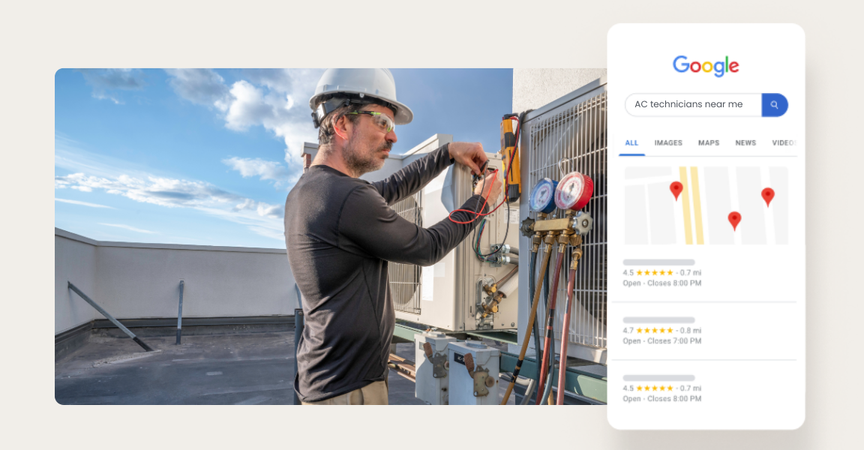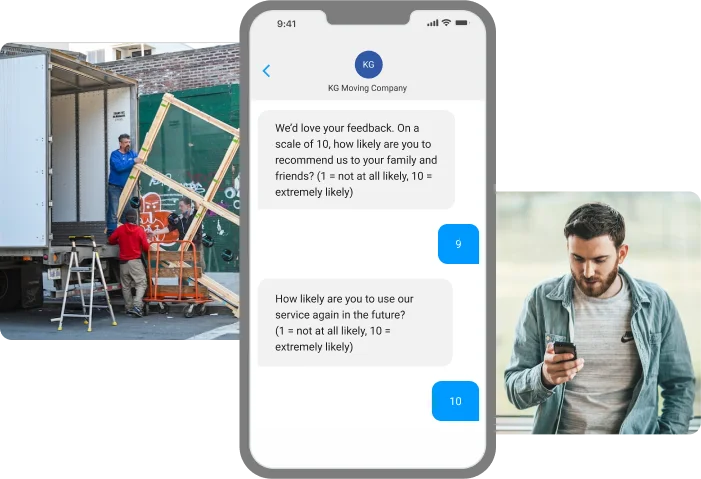In the scorching supper heat or the freezing winter chill, homeowners rely on their heating, ventilation, and air conditioning (HVAC) systems to keep them comfortable. But with so many HVAC businesses vying for attention, how can you ensure that your company is the one they call when the temperature rises or falls? The key lies in effective HVAC marketing. By leveraging the right strategies and tools, you can boost your online presence, drive more leads, and ultimately, increase revenue.
In this guide, we’ll explore the most impactful HVAC marketing strategies, including SEO, social media, and email marketing, to help you grow your business and stay ahead of the curve.
Table of contents
- Understanding your target audience
- Building a strong online foundation
- Digital marketing strategies for HVAC businesses
- Customer acquisition and retention strategies
- Emerging trends and technologies in HVAC marketing
- HVAC industry-specific marketing challenges and how to overcome them
- Putting it all together: How to create a comprehensive HVAC marketing strategy
- FAQs on HVAC marketing strategies
- Take your HVAC business to new heights with Birdeye
Understanding your target audience
Before you can effectively market your HVAC business, you need to understand who your ideal customers are. This involves creating buyer personas that capture the essence of your target audience.
So, how do you Identify ideal customer personas? Your ideal buyer personas might include, but are not limited to:
- Homeowners with young families who prioritize comfort and air quality
- Retirees on a fixed income who need affordable HVAC solutions
- Environmentally conscious individuals who seek energy-efficient systems
- Commercial property managers responsible for maintaining large buildings
Once you have identified your ideal customer personas, delve deeper into their needs, pain points, and motivations:
- What are their goals and aspirations? (e.g., saving energy, reducing costs)
- What challenges do they face? (e.g., outdated systems, poor air quality)
- What motivates them to make purchasing decisions? (e.g., recommendations, online reviews)
- What are their communication preferences? (e.g., phone, email, social media)
By understanding your target audience, you can tailor your marketing strategies to resonate with them, address their pain points, and meet their needs.
Building a strong online foundation
Having a strong online presence is crucial for any business to thrive in today’s competitive digital world. It’s no longer enough to just have a website – you need to make sure it’s working hard for you. To achieve that, you need to focus on a few key areas:
1. Local SEO strategies for HVAC businesses
When people search for HVAC services in your area, you want your business to show up near the top of the list. That’s where local SEO comes in. By optimizing your website and online listings for local search terms, you can increase your visibility and attract more local customers. This includes using keywords like “HVAC services near me” or “air conditioning repair in [your city].”
2. Website design and optimization best practices
Your website is often the first impression people have of your business, so make it count. A well-designed website should be easy to navigate, mobile-friendly, and load quickly. It should also clearly communicate your services, values, and unique selling points. By optimizing your website, you can improve user experience and increase the chances of converting visitors into customers.
3. Google Business Profile optimization
Google Business Profile (GBP) is a free tool that helps you manage your online presence across Google. By claiming and optimizing your listing, you can:
- Provide accurate and up-to-date business information
- Share updates and offers with customers
- Respond to reviews and messages
- Improve your local search rankings

4. Online review management and reputation building
Online reviews are a powerful tool for building trust with potential customers. Encourage happy customers to leave reviews on platforms like GBP, Facebook, and Bing. Respond promptly to both positive and negative reviews, and use them as an opportunity to showcase your customer service skills. By building a strong online reputation, you can attract more customers and stay ahead of the competition.
By focusing on these four areas, you can build a strong online presence that attracts more customers, builds trust, and drives growth for your HVAC business.
Digital marketing strategies for HVAC businesses
HVAC businesses need to be where their customers are online. Here are four digital marketing strategies for HVAC businesses to reach, engage, and convert more customers:
1. Social media marketing and advertising
Social media platforms like Facebook, Instagram, and Twitter (now called X) are perfect for building relationships with your target audience. Share valuable content, industry insights, and company news to establish your brand as a trusted authority. Use social media advertising to target specific demographics, interests, and behaviors, ensuring your message reaches the right people.
2. Email marketing and automation
Email marketing allows you to nurture leads, share valuable content, and encourage customer loyalty. By automating email sequences, you can:
- Welcome new subscribers and introduce your brand
- Share educational content and industry insights
- Offer exclusive promotions and discounts
- Encourage referrals and reviews
3. Content marketing ideas
Content marketing helps you attract and engage your target audience by providing value beyond your services. You can host live or recorded webinars on topics like energy efficiency, HVAC maintenance, or smart home technology. You can also create eBooks or comprehensive guides on HVAC-related topics or produce informative videos showcasing your expertise, like “HVAC tips and tricks” or “Meet the Technician.”
4. Influencer partnerships and affiliate marketing
Partner with influencers in the HVAC industry or complementary fields (like home decor or energy efficiency) to:
- Reach new audiences and build credibility
- Promote your services or products to their followers
- Collaborate on content creation and product development
Affiliate marketing allows you to partner with other businesses or individuals, offering commissions for referrals or sales generated through their unique affiliate link.
By incorporating these digital marketing strategies for HVAC businesses into your overall marketing plan, you can increase brand awareness and credibility, which will help you drive website traffic and generate leads. It will also encourage customer loyalty and retention, helping you stay ahead of the competition in the HVAC industry.
Birdeye, your all-in-one platform for a strong online presence
Automate reviews, ratings, listings & reputation management with Birdeye.
Customer acquisition and retention strategies
Attracting new customers is crucial, but retaining existing ones is just as important. Focus on the following strategies to drive growth and build a loyal customer base:
1. Customer referral programs
Referrals from satisfied customers are a powerful marketing tool. Implement a referral program that rewards customers for referring friends and family. It must offer incentives, such as discounts or gift cards, for successful referrals, track referrals, and follow up with new leads.
Birdeye’s customer referral software can significantly benefit HVAC businesses by leveraging the power of word-of-mouth marketing. Here are some key ways it can help:
- Automated referral campaigns: Save time and effort with automated referral campaigns.
- Multi-channel referrals: Customers can refer via email, text, and social media.
- Customizable templates: Use customizable templates for consistent branding.
- Incentives and rewards: Boost referrals with discounts or gifts.
- Real-time engagement: Engage quickly with new referrals through a smart inbox.
- Comprehensive reporting: Get detailed reports to optimize referral strategies.
2. Loyalty programs and retention strategies
Loyalty programs and retention strategies are designed to reward and retain existing customers, encouraging them to continue doing business with your HVAC company. Here are some ideas to consider:
Loyalty programs with exclusive benefits
One way to do this is by offering priority scheduling for loyalty program members, ensuring they receive faster service when they need it. Additionally, provide exclusive discounts on services, parts, or maintenance plans to show appreciation for their loyalty. Loyalty program members can also receive special promotions, such as free maintenance checks or discounts on new equipment, to further incentivize their loyalty. Finally, offer VIP access to exclusive events like HVAC workshops, hosting international events, or seminars to make them feel valued and part of a select group.
Regular maintenance plans or service agreements
Regular maintenance plans can include scheduled maintenance visits, priority scheduling, and discounts on repairs, providing customers with peace of mind and cost savings. Service agreements can take it a step further by including regular maintenance, repairs, and replacements for a fixed fee, giving customers a comprehensive solution for their HVAC needs.
Personalized communication and tailored offers
Send personalized emails with tailored offers, maintenance reminders, and industry tips to keep them engaged and informed. Offer customized promotions based on customers’ service history, equipment, and preferences to show you understand their unique needs. Regularly check in with loyalty program members to ensure they’re satisfied and address any concerns, providing a high level of customer service and support.
Surveys and feedback mechanisms
Conduct regular surveys to gather feedback on services, technicians, and overall experience, helping you identify areas for improvement. Establish feedback mechanisms, such as online review platforms or comment cards, to encourage customers to provide feedback. Finally, follow up with customers to address concerns and implement changes based on feedback, demonstrating your commitment to customer satisfaction and continuous improvement.

3. Upselling and cross-selling techniques
Boost sales and customer satisfaction with upselling and cross-selling techniques. During maintenance visits, offer premium upgrades like advanced air filters or smart thermostats that enhance the customer’s HVAC experience. These upgrades increase revenue and provide a better experience, leading to happier customers and loyalty.
Also, recommend complementary products like air purifiers, humidifiers, or duct cleaning services that work well with their existing system. Bundle services or offer package deals to incentivize customers to buy more. Educate them on the benefits, like saving energy, reducing costs, or improving indoor air quality. By doing so, you’ll increase sales and provide a comprehensive solution that meets their needs.
4. Customer experience and satisfaction
Delivering exceptional customer experiences is the key to building a loyal customer base and driving growth. This means being prompt, professional, and courteous in every interaction. Respond quickly, be friendly, and ensure every touchpoint is a positive one. Clear communication and transparent pricing are also a must. By being open and honest, you build trust and establish a strong foundation for a long-term relationship.
But that’s just the beginning. To turn satisfied customers into loyal advocates, you need empathetic and helpful support. Listen actively, understand their needs, and offer personalized solutions. Be proactive and responsive, addressing issues quickly and effectively. And don’t forget to ask for feedback and act on it. This will help you improve and stay ahead of the curve. By prioritizing customer experience, you’ll drive retention, growth, and long-term success.
Emerging trends and technologies in HVAC marketing
HVAC businesses need to stay ahead of the curve by embracing emerging trends and technologies, such as:
1. Smart home technology
Smart home technology is revolutionizing the way HVAC businesses operate and market their services. With the rise of smart thermostats and connected HVAC systems, customers can now control and monitor their heating and cooling systems remotely. This presents an opportunity for HVAC businesses to offer smart home integration services, energy efficiency solutions, and remote monitoring and maintenance. By embracing smart home technology, HVAC businesses can differentiate themselves, increase customer engagement, and offer new revenue streams.
2. Voice search
Voice search is changing the way customers find and interact with HVAC businesses. With the rise of voice assistants like Alexa and Google Home, customers can now search for HVAC services using voice commands. This means HVAC businesses need to optimize their website and online presence for voice search by using natural language keywords, long-tail phrases, and local SEO strategies. By doing so, HVAC businesses can increase their visibility, drive more leads, and stay ahead of the competition.
3. AI-powered chatbots
AI-powered chatbots are transforming the way HVAC businesses interact with customers. Chatbots can help HVAC businesses provide 24/7 customer support, answer frequently asked questions, and even schedule appointments. By integrating chatbots into their website and social media channels, HVAC businesses can improve customer engagement, reduce response times, and increase conversion rates.
Additionally, chatbots can help HVAC businesses collect customer data, preferences, and feedback, enabling them to offer personalized services and improve customer satisfaction.
Birdeye’s AI-powered chatbot offers several features that can significantly benefit HVAC businesses: Lead conversion: The chatbot can engage website visitors in real-time, converting them into leads by capturing contact information and following up via text. Customer support: It uses AI to answer frequently asked questions, freeing up your team to handle more complex inquiries. Appointment booking: The chatbot can book appointments directly through the chat, making it convenient for customers to schedule HVAC services. 24/7 availability: With rules-based auto-replies, the chatbot can engage visitors even during off-business hours, ensuring that potential leads are never missed. Personalization: Businesses can customize the chatbot with their logo, colors, and messages, creating a consistent brand experience. Efficiency: The chatbot streamlines customer interactions and improves response times by automating responses and organizing conversations in a smart inbox.
HVAC industry-specific marketing challenges and how to overcome them
The HVAC industry faces unique marketing challenges that can make it difficult to attract and retain customers. These challenges require HVAC businesses to develop targeted marketing strategies that address their specific needs and differentiate themselves from competitors. Let’s take a closer look at these challenges and explore how to overcome them.
1. Seasonal fluctuations in demand
HVAC businesses experience significant seasonal fluctuations in demand, with peak demand during extreme weather conditions and lower demand during milder seasons. This creates marketing challenges, such as managing workload and resources during peak seasons, maintaining customer engagement during off-peak seasons, and balancing marketing efforts to address varying demand levels.
To overcome these challenges, HVAC businesses can use seasonal marketing strategies, such as:
- Offering seasonal promotions and discounts
- Providing maintenance and repair services during off-peak seasons
- Utilizing email marketing and social media to stay top-of-mind during slower periods
2. Competition from DIY solutions and big-box stores
The rise of DIY solutions and big-box stores has increased competition for HVAC businesses, offering customers lower prices and convenient solutions. To compete, HVAC businesses must highlight the benefits of professional installation and maintenance, emphasize the quality and reliability of their services and products, and offer warranties, guarantees, and maintenance plans to differentiate themselves.
3. Regulatory challenges and compliance issues
HVAC businesses must navigate complex regulatory environments, including environmental regulations, safety standards, and licensing and certification requirements. Staying up-to-date with changing regulations, investing in training and certification for technicians, and developing compliance-focused marketing messaging can help HVAC businesses reassure customers of their expertise and reliability.
Putting it all together: How to create a comprehensive HVAC marketing strategy
A well-planned marketing strategy is crucial for the success of any HVAC business. Here’s how to develop a winning approach:
1. Create a marketing budget and ROI analysis
- Allocate a percentage of your revenue to marketing (typically 5-10%)
- Break down the budget across different marketing channels
- Estimate the potential return on investment (ROI) for each channel
- Consider both short-term and long-term marketing investments
2. Measure and track marketing performance
- Set clear, measurable goals for each marketing initiative
- Use analytics tools to monitor website traffic, lead generation, and conversions
- Track customer acquisition costs and lifetime value
- Implement call tracking to measure phone-based leads
- Regularly review social media engagement and growth
3. Adjust and optimize marketing strategies
- Analyze data regularly to identify high-performing channels
- A/B test different marketing messages and visuals
- Reallocate the budget from underperforming to successful strategies
- Stay updated on industry trends and adjust tactics accordingly
- Continuously gather customer feedback and adapt your approach
4. Develop a multi-channel approach
- Combine online and offline marketing tactics
- Ensure consistent branding across all platforms
- Tailor content to each channel’s audience and format
5. Focus on local SEO and online presence
- Optimize your Google Business Profile listing
- Encourage and manage customer reviews
- Create location-specific content and landing pages
- Implement content marketing
- Develop educational blog posts, videos, and infographics
- Address common HVAC issues and solutions
- Showcase your expertise through case studies and testimonials
6. Leverage email marketing
- Build and segment your email list
- Create targeted campaigns for different customer groups
- Offer valuable content and promotions to nurture leads
7. Utilize paid advertising
- Invest in Google Ads and social media advertising
- Target specific demographics and locations
- Retarget website visitors with relevant ads
By following these steps and continuously refining your approach, you can create a comprehensive HVAC marketing strategy that drives growth and establishes your brand as a leader in the industry.
FAQs on HVAC marketing strategies
The most effective HVAC marketing strategies include developing a strong online presence, leveraging social media and email marketing, utilizing search engine optimization (SEO), investing in paid advertising, and implementing customer referral programs.
To improve your HVAC company’s local SEO, optimize your Google My Business listing, use location-specific keywords on your website, build high-quality local citations, and encourage customers to leave online reviews.
Customer reviews are crucial in HVAC marketing as they build trust and credibility with potential customers, improve local SEO, and increase conversion rates. Encourage satisfied customers to leave reviews on your website and social media channels.
Use social media to market your HVAC business by creating engaging content, utilizing paid social media ads, sharing customer testimonials, and providing exceptional customer service through social media channels.
Email marketing plays a significant role in HVAC marketing strategies as it allows you to nurture leads, promote special offers and discounts, share valuable content, and build strong relationships with customers and potential customers. Build and segment your email list to maximize effectiveness.
Take your HVAC business to new heights with Birdeye
Birdeye’s cutting-edge AI-powered platform is designed to revolutionize your marketing strategy, driving unprecedented growth and customer loyalty.
Imagine having a constant flow of authentic customer reviews, showcasing your exceptional service, and building trust with potential customers. With Birdeye, you can:
- Unlock the power of online reputation management, effortlessly collecting and showcasing 5-star reviews
- Supercharge your social media presence, engaging customers and growing your brand
- Gain actionable insights from customer feedback, refining your services to meet their needs
- Streamline communication and scheduling, saving time and delighting customers
- Dominate local search rankings, attracting more customers and outshining the competition
Here’s what Alisa Makowski, Marketing Director at Furnace Family, an HVAC business based in Edmonton, Canada, had to say about Birdeye:
“There’re three things we found with Birdeye that were beneficial for any small business owner: The ease of using the dashboard, the ability to send texts and emails, and the ability to turn negative situations around.”
– Alisa Makowski, Marketing Director at Furnace Family
Join the ranks of forward-thinking HVAC businesses that have already discovered the secret to success with Birdeye. Watch the free demo today to learn more.

Originally published




![[Feature image ] Customer-centric marketing- how to win, retain, and grow your customer base in 2025](https://birdeye.com/blog/wp-content/uploads/Feature-image-Customer-centric-marketing-how-to-win-retain-and-grow-your-customer-base-in-2025-375x195.jpg)




